
Browse an alphabetical list of photographs. These historical images portray people, places, and events before, during, and after World War II and the Holocaust.
<< Previous | Displaying results 1451-1475 of 2641 for "Photo" | Next >>
Jozef Gabčik was a Slovak member of the Czechoslovak armed forces who trained in Great Britain and parachuted into German-occupied Czech territory to assassinate Reinhard Heydrich. As Heydrich traveled on a familiar route to the airport to fly to Hitler's headquarters for a meeting, two agents succeeded in rolling a modified British anti-tank grenade under his car. The blast itself did not cause immediate death. Heydrich died a little over a week later. The official autopsy report determined that the…

American judge Benjamin Barr Lindsey and his wife on a ship. Judge Lindsey's writings were among the texts the Nazis singled out during the 1933 public burnings of books. Photo dated December 4, 1915.
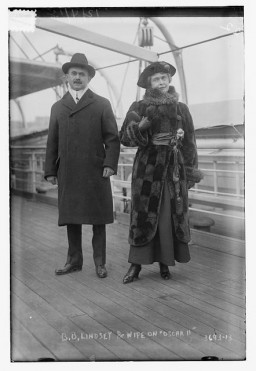
Judge Thomas Buergenthal, member of the Inter-American Court of Human Rights, San Jose, Costa Rica, 1980.

Judge Thomas Buergenthal (top row, fifth from left) and other members of the United Nations Human Rights Committee. 1995.
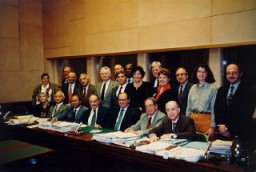
Judge Thomas Buergenthal (front row, right) with other members of the Inter-American Court of Justice in San Jose, Costa Rica. Thomas served from 1979–91 and was president from 1985-1987. San Jose, Costa Rica, 1980.
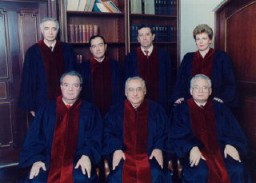
The International Military Tribunal was a court convened jointly by the victorious Allied governments. Here the Soviet, British, American, and French flags hang behind the judges' bench.
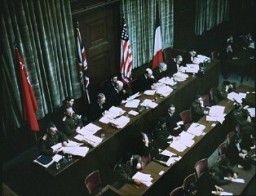
Judges in the trial of 19 men accused of committing atrocities at the Dora-Mittelbau concentration camp, located near Nordhausen. Dachau, Germany, September 25, 1947.
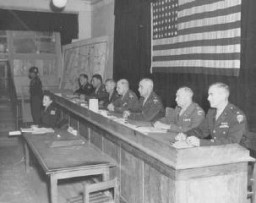
An armored car parked outside the gate of the Palace of Justice in Nuremberg on the day the judgment of the International Military Tribunal was handed down. Nuremberg, Germany, October 1, 1946.
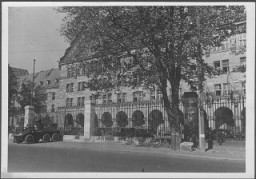
Juergen Stroop (third from left), SS commander who crushed the Warsaw ghetto uprising. Warsaw, Poland, between April 19 and May 16, 1943.
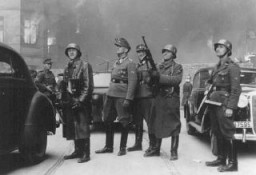
Photograph of Julian Noga, a Polish prisoner (marked with an identifying patch bearing a "P" for Pole) imprisoned in the Flossenbürg concentration camp. Germany, between August 1942 and April 1945.
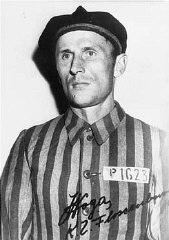
Julien Bryan was an important US documentary filmmaker and photographer who captured the everyday life, work, and culture of individuals and communities in many countries around the globe. Bryan was filming in western Europe in the summer of 1939. In the first week of September 1939, Bryan made his way to Warsaw just as all foreign reporters, diplomats, and Polish government officials were fleeing the capital in the wake of the German invasion. One of the few foreign photographers left in the city, he…
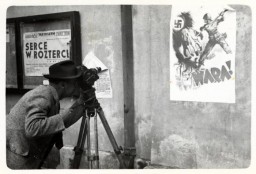
Julien Bryan was an important US documentary filmmaker and photographer who captured the everyday life, work, and culture of individuals and communities in many countries around the globe. Bryan was filming in western Europe in the summer of 1939. In the first week of September 1939, Bryan made his way to Warsaw just as all foreign reporters, diplomats, and Polish government officials were fleeing the capital in the wake of the German invasion. One of the few foreign photographers left in the city, he…
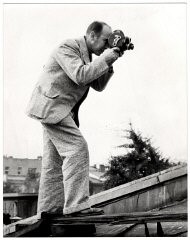
Nazi official Julius Streicher, founder of the antisemitic newspaper Der Stuermer (The Attacker) and organizer of the anti-Jewish boycott. Germany, date uncertain.
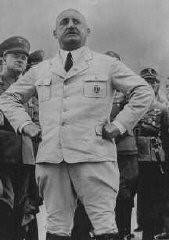
At the Kaiser Wilhelm Institute for Anthropology, Human Genetics, and Eugenics, a racial hygienist measures a woman's features in an attempt to determine her racial ancestry. Berlin, Germany, date uncertain.
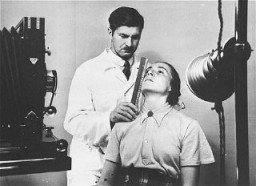
Portrait of the family of Mushon and Rebeka Kamchi in Bitola. Isak Kamchi is pictured in the front row at the right. Isak was born in Bitola. Several of his siblings and cousins left Macedonia for Palestine and North America before the war. During World War II, Isak served as the leader of a partisan unit operating in Croatia. He established a safehouse at his parent's home in Zagreb where partisans could rest and recuperate. His mother ran the safehouse, cooking for the men and nursing them back to…
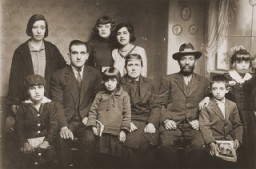
Defendants Karl Dönitz (left), Erich Raeder (center), and Baldur von Schirach under guard in the defendants' dock at Nuremberg.
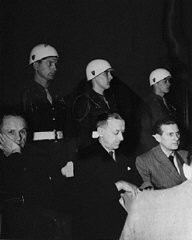
Photograph of Karl Höcker. He is standing in front of an air raid shelter. From Karl Höcker's photograph album, which includes both documentation of official visits and ceremonies at Auschwitz as well as more personal photographs depicting the many social activities that he and other members of the Auschwitz camp staff enjoyed. These rare images show Nazis singing, hunting, and even trimming a Christmas tree. They provide a chilling contrast to the photographs of thousands of Hungarian Jews…
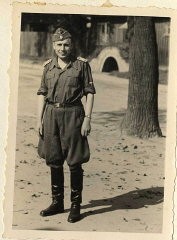
Karl Höcker (on left, looking at the camera) relaxes with SS physicians, including Dr. Fritz Klein (far left), Dr. Horst Schumann (partially obscured next to Klein, identified from other photographs), and Dr. Eduard Wirths (third from right, wearing tie). From Karl Höcker's photograph album, which includes both documentation of official visits and ceremonies at Auschwitz as well as more personal photographs depicting the many social activities that he and other members of the Auschwitz camp…
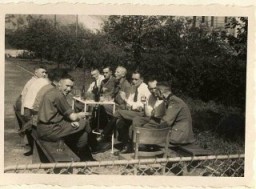
Kaufbeuren euthanasia facility. Killings by lethal injection took place in Kaufbeuren. Germany, 1945.
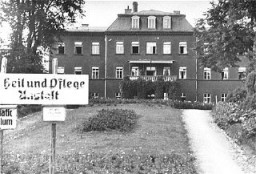
The entrance gate to Kaufering IV subcamp of Dachau. This photograph was taken after liberation. Near Landsberg, Germany, after April 28, 1945.
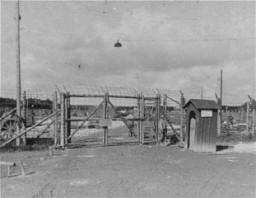
Site at which the SS shot and burned the last 45 of 48 prisoners at Chelmno. The other three prisoners escaped. Chelmno, Poland, 1945.
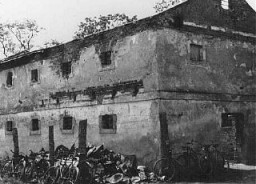
King Christian X. According to popular legend, King Christian X chose to wear a yellow star in support of the Danish Jews during the Nazi occupation of Denmark. In another version, the Danish people decided to wear a yellow star for the same reason. Both of these stories are fictional. However, the legend conveys an important historical truth: both the King and the Danish people stood by their Jewish citizens and were instrumental in saving the overwhelming majority of them from Nazi persecution and death.
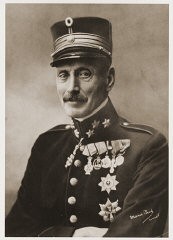
Klara Taussig and Ernst Brecher go on an outing in the Austrian countryside before their marriage. They later had a son, Heinz, who was born on August 29, 1932 in Graz, Austria. where his father was a merchant. After the Germans annexed Austria in 1938, Klara and Ernst sent Heinz to live with friends of an aunt in Zagreb. Heinz survived and eventually came to the United States on the Henry Gibbins, a military troop transport. Klara and Ernst died in the concentration camps. Photograph taken…
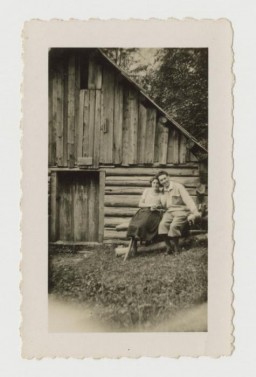
SS Lieutenant Klaus Barbie in Nazi uniform. Barbie, responsible for atrocities against Jews and resistance activists in France, was known as the "Butcher of Lyon." Germany, date uncertain.
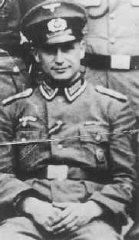
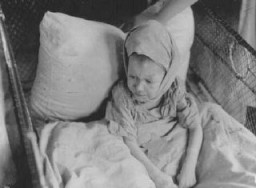
We would like to thank Crown Family Philanthropies, Abe and Ida Cooper Foundation, the Claims Conference, EVZ, and BMF for supporting the ongoing work to create content and resources for the Holocaust Encyclopedia. View the list of donor acknowledgement.